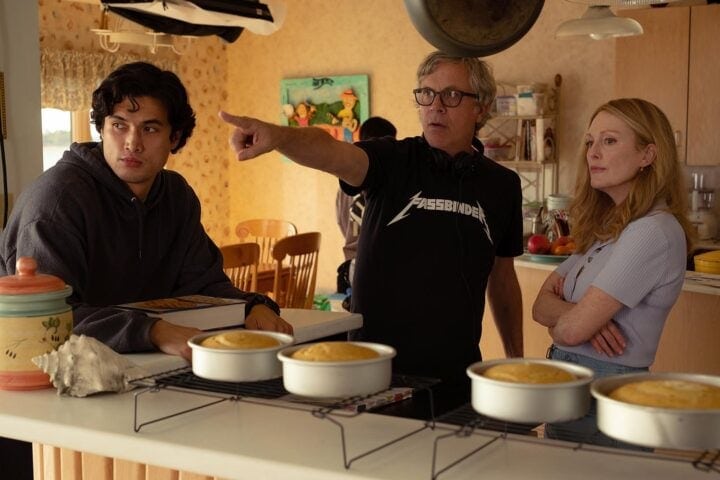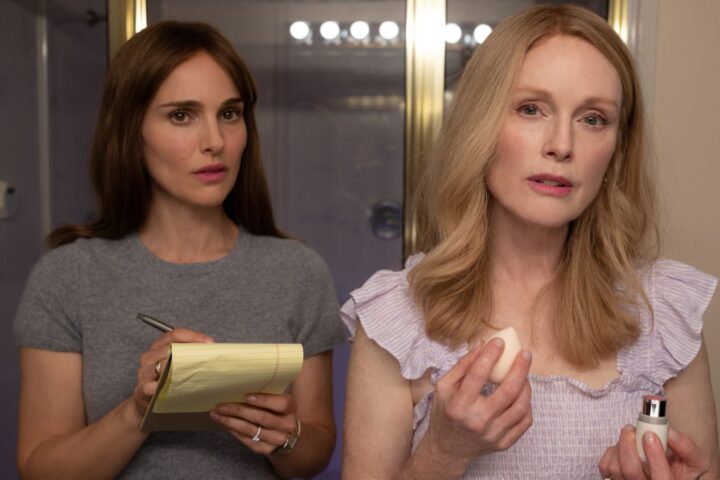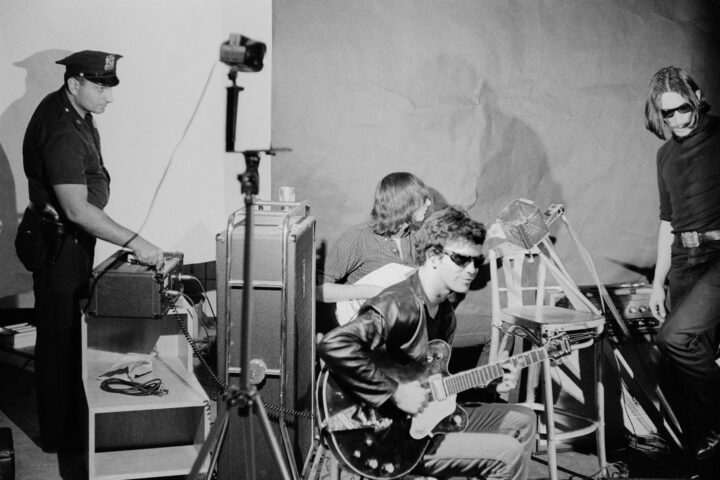Todd Haynes’s films are never just about their plot or characters. Each of them also serves as portrait and commentary on the time in which the events occur. This holds no less true for his first foray into documentary filmmaking, The Velvet Underground, a chronicle of the experimental rock band and the artistic scene that birthed them.
Given his deconstructionist representations of musicians David Bowie and Bob Dylan Velvet Goldmine and I’m Not There, respectively, the idea of making a standard biographical documentary was likely never on the table for Haynes. But what he’s crafted with The Velvet Underground goes beyond merely eschewing the standard tropes of the format.
The film provides a rich overview of the group’s groundbreaking music and their vibrant personalities to satisfy faithful fans as well as the uninitiated. But Haynes never narrows his focus to just the band alone, weaving a vibrant visual and aural multimedia tapestry that itself feels of a piece with the avant-garde movement that forged the group.
I spoke with Haynes shortly after The Velvet Underground’s North American premiere at the New York Film Festival. Our conversation covered how he crafted the film’s split-screen aesthetic, what it has in common with his fictional portraits of artists, and why Lou Reed’s death had to serve as a “structuring absence” for the documentary.
I don’t think my identification with the Velvet Underground’s music clicked intellectually for me until someone in your documentary observed that Lou Reed was “communicating to people who were on the outside.” Did you have any similar revelation that changed your relationship to the band?
I don’t know if there was a click. There were moments of recognition when we were looking at the avant-garde films in particular. As an example, I knew we wanted to play the drones of La Monte Young, and it’s set up in the narration that the drone experimentation was happening in John Cale’s life with La Monte where they were stretching out single notes of music for hours. Then Jonas Mekas takes Andy [Warhol] to a La Monte concert, and then we see Andy’s early films. But it wasn’t until I heard the drone music while watching Andy Warhol’s films that I feel like viewers get the chance to go “Ahh!” and feel the connection themselves. Someone can tell you all these things, but it’s not until you actually put this thing together yourself that you experience it as your own. I think little things like that were happening.
Another example was the idea of showing the screen tests in their entirety—an entire reel of Lou Reed just existing on film being coupled with images and narration about his childhood. To literally watch a subject who you’re describing [as he’s] breathing, blinking, sometimes looking off as if he’s looking at the thing on the other screen, you draw little connections, and you read little things into his presence. With things like that, we were just like, “Ahh, this works! This is producing more than I even thought it would beyond the concept.”
You’ve said that there are two-and-a-half hours of footage contained in this documentary with a two-hour runtime. Was that wealth of material factoring into the decision to rely on these split-screens to make the juxtapositions?
It was the other way around. We started with curating a huge list of movies that we had in the Avid, but they were organized by theme, location, content, as best as possible. It wasn’t an academic way of organizing them, so they were always at our disposal. Affonso Gonçalves was on one Avid, Adam Kurnitz was on another, and I was on a third, so we were all just cutting away. But we had the concepts for the multiple screens from the very beginning. We had the material to do that and to try, “Oh, this one works nicely, but this one works better.” Sure, there were some of them during the licensing process, once we really had closer to a locked cut, that we were like, “Oh, we have trouble with this one archive, or a filmmaker approval is too costly, can we look for an alternative for this?” and then we would have to find something else. But for the most part, we really got everything we needed and wanted. We struck really good deals with the Warhol Museum where we weren’t paying by frame. But it took negotiation, time visiting the archives, and getting to know them to get to that point.
That example with the Lou Reed close-up footage also points to the issue of his absence. How do you weigh allowing him to speak for himself with archival interviews against letting others speak for or about him in the present?
It was a structuring absence, obviously. You have challenges in general, the first one being that there isn’t much traditional footage for this band like you would find for other well-known ones—promo material, concert footage, that kind of stuff. We had to think of ways to extract what we could from the Warhol films that show the band and figure out the most artful and interesting ways of bringing them to life because almost none of them were live performances.
But with Lou, that was a special challenge. It meant scouring interviews of him over the years, knowing I didn’t want to see clips from different areas in funky video because of the aesthetic integrity I wanted to preserve for the movie. But I wanted his voice, his wit, his unique perspective that no one else would have, and the tenor of that voice. What was interesting is that he doesn’t talk a whole lot about the Velvet Underground over the years. Not only is he a difficult person to interview, he’s mostly interested in talking about the record that he’s about to release—as most artists would be—and not necessarily comparing it to his legendary first band. It was a bit piecemeal with what we could find that was about the Velvet Underground.
Look, if he had been alive, it would be a different movie. That would have been a movie I would definitely have wanted to make. But he wasn’t, and so this is what we had. But it did interesting things. It meant that the clips that we wait to show of him toward the end of the movie—the Bob Colacello interview from Interview magazine where Andy Warhol is in the room, which is out of our timeline in 1973—lands really meaningfully because you haven’t seen Lou talk on film through the whole movie. And, similarly, the live footage of Lou and John playing acoustically on stage in Paris in ‘72 with Nico, a famous little reunion concert that they did, also has that impact because you’ve been awaiting it.
Lou Reed was notoriously enigmatic. Were you content to let him remain as such, or did you want to get to the bottom of him through this project?
I think it was both. I don’t think I wanted to get to the bottom of him because I don’t know that one can, and I don’t think one should. I think he wouldn’t let you anyway. But in hearing from those who knew him from a very young age, the Lou that they describe was so entirely the Lou that people talk about at the end of his life. It’s the same guy, whether he was famous or not. It was the same person who would use hostility and anger as a defense. But he was also witty, brilliant, moody, and vulnerable. And as his girlfriend from college says, it all came from an insecurity that she didn’t really understand why he had because he was so exceptional.
You really feel like he’s somewhat fully formed as a complicated artist, like many artists are with things that you just can’t penetrate or explain. I do feel like, in that way, it seems accurate. His family members were worried about the depiction of Lou and the family, like Merrill Reed Weiner, Lou’s sister, expresses in the film. But even just today, I got an email from her. I saw her at the party after the New York Film Festival premiere, and she said that she was just sobbing through the movie. She said, “You are now a member of the Reed family.” It was really moving, and she just reiterated through that wonderful email. That means so much.

There’s a version of the story that flattens them his parents into villains, and you’re willing to let us sit with the complexity of their influence on Lou Reed.
The more convenient version is just, “Oh, the fucked-up parents who are so homophobic!” But he had already written “Heroin” by the time he was in high school. He exhibited all of those things early on. And he wasn’t always happy, so parents want to figure out a way to help. The recourses and the practices of treatment at the time were what they were; it’s not the parents who invented electroshock treatment and advised it. I don’t know that they were the warmest people in the world, but I don’t think they were driven by a manic homophobia.
It feels like you’ve been interested in capturing this duality since as early as Velvet Goldmine with the Citizen Kane-style lens of reconfiguring a larger-than-life figure through the stories of people around him. This allows us to arrive at a version of Lou Reed, but not the entirety of him. People like him are both entirely present for us but also somewhat unknown because we can never know everything about anybody.
I think that’s an apt way of comparing the two movies, which are still quite different even though I think of this almost as a prequel to Velvet Goldmine. Both are saying, yeah, there are things that are never going to be knowable, reducible, or consistent about who that person is with all the veils and layers. We never can know anybody entirely. There’s the assumption that we can know our best friend, which completely isn’t true either. There are things in everybody’s life and character that are out of reach, very guarded, or whatever it is. People’s parents die, and they’re like, “Oh my God, I never knew that this happened to my mom when she had an affair,” but at the same time, what we do know is their work. They’re artists, and they work a lot of stuff out in their art. Sometimes we have a hard time going, “Wait a minute, everything we need to know about this person they’ve given us already.”
I really hung onto what you were saying at the premiere about Velvet Goldmine and I’m Not There, where you described that in fictionalizing larger-than-life figures David Bowie and Bob Dylan, viewers had the chance to “navigate between what they know about these people and what I was doing in the strategy of those films.” Do you see the documentary portrait in The Velvet Underground as analogous or something so separate that it required an entirely different mindset of filmmaking?
Yeah, but probably less in reportage that the film gives you than in a kind of experiential way of hearing the music freshly by not only spending so much time in the etymology of the music—the sources of the artists, where they came from, what they were doing, and how they found each other—but also in just using the avant-garde films as our visual language in illustrating this period and the sounds. I think it makes you think in ways that you could never think when you’re reading it in a book, and it gives you a richer, deeper, and more subtle meaning or experience that isn’t necessarily concrete or material. It’s something else that you invent or create as you watch it. It’s like you’re dreaming through it. [Film critic] Amy Taubin and I were on this panel a couple days ago, and someone asked her what it was like to see the movie having been [at Warhol’s Factory]. And she said, “It’s like being there again.” And that is what I hoped, but I don’t know because I wasn’t there. I’m only pulling together the pieces to give somebody that experience, but that’s pretty wild to hear that.
Is that part of why you said you didn’t want to explore the Velvet Underground primarily through their lyrics like a more traditional bio-doc would do?
Yeah, or a lot of a lot of talking heads telling you the story, “And then we flew here, and then we did that, and then we did this.” You could almost relay that story later to your partner, family, or friends. You could say, “This is what that was about, and this is the storyline.” You can’t really do that with this movie. It’s something everybody has to experience for themselves because the experience isn’t that portable. That was why I chose to really just talk to people who were there and not talk to people, among whom there will be so many great examples, who were inspired by the music years later and can tell us why it meant something to them and why the Velvet Underground are important. I just was like, “There’s no beginning and ending of that list, so I don’t want to have to even go there.” Hopefully the movie will let you know why it’s important to you and why you might want to get more into it on your own.
Among the interview footage that you shot with Ed Lachman, I only counted two close-ups: John Cale and Mary Woronov. Did you shoot more close-ups that didn’t make the film, or was there a reason why those two figures got that treatment?
Because it’s an improvisation you don’t know what they’re going to say, and Ed didn’t even have a list of my questions, he was choosing places to zoom in and out. Very few times did we do any radical re-framings, so it was what he did in the camera. They were kind of accidental. The only time we go full frame on one of the interviewees—usually they’re in the 1.33:1 aspect ratio that all the 16mm material is, so we put them flush left or right with the black border hanging on the other side—is when John Cale says how to be elegant and how to be brutal.
Do you think any of what you learned from making The Velvet Underground will spill over into Fever, your upcoming Peggy Lee project?
Not anything I can think of literally from relying so much on archival material. Even saying that is imprecise with this movie because it’s not historical archives that we’re mostly using in the movie. It’s other films. In that way, it’s just such a unique set of conditions that presented themselves to me and all of us, and that’s what was so cool about it. You can’t think of any other band that would ever present the same culture, particularly cinematically—only the Velvet Underground would have that intimate relationship with it. It really told its own story, and I just followed the leads of what I was given. We were able to play with all that stuff and have such a good time experimenting with it ourselves. I felt so honored every day, almost like there was something illegal about using it as freely as we did.
Since 2001, we've brought you uncompromising, candid takes on the world of film, music, television, video games, theater, and more. Independently owned and operated publications like Slant have been hit hard in recent years, but we’re committed to keeping our content free and accessible—meaning no paywalls or fees.
If you like what we do, please consider subscribing to our Patreon or making a donation.




